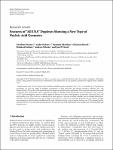Features of “All LNA” Duplexes Showing a New Type of Nucleic Acid Geometry
Förster, Charlotte
Eichert, André
Oberthür, Dominik
Betzel, Christian
Geßner, Reinhard
Nitsche, Andreas
Fürste, Jens P.
"Locked nucleic acids" (LNAs) belong to the backbone-modified nucleic acid family. The 2'-O,4'-C-methylene-β-D-ribofuranose nucleotides are used for single or multiple substitutions in RNA molecules and thereby introduce enhanced bio- and thermostability. This renders LNAs powerful tools for diagnostic and therapeutic applications. RNA molecules maintain the overall canonical A-type conformation upon substitution of single or multiple residues/nucleotides by LNA monomers. The structures of "all" LNA homoduplexes, however, exhibit significant differences in their overall geometry, in particular a decreased twist, roll and propeller twist. This results in a widening of the major groove, a decrease in helical winding, and an enlarged helical pitch. Therefore, the LNA duplex structure can no longer be described as a canonical A-type RNA geometry but can rather be brought into proximity to other backbone-modified nucleic acids, like glycol nucleic acids or peptide nucleic acids. LNA-modified nucleic acids provide thus structural and functional features that may be successfully exploited for future application in biotechnology and drug discovery.
Dateien zu dieser Publikation
Keine Lizenzangabe

